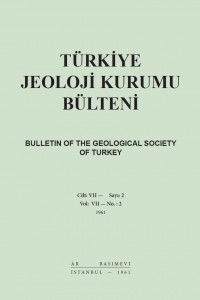Derleme
Yıl 1961,
Cilt: 7 Sayı: 2, 34 - 56, 30.06.1961
Öz
In the geologic literature and on the published maps of Turkey the term flysch is frequently applied to a great variety of deposits of Cretaceous and Tertiary age. Since most of the geologic work has been carried out by European-trained geologists, this is not surprising.
It is, however, somewhat baffling to the American geologists and a certain reluctance on their part to use the term can be observed. This has also its good reasons, as will be pointed out later.
There is no doubt that the usage of the term flysch has been confusing in the past and its application abused, which has led many earnest students of the problem to advocate complete abandoning of the term.
However, not only are we still facing its application in the publications of all areas with alpine-type geology, we also feel that the term flysch has a definite value in those areas, if properly defined and understood.
The purpose of this talk, therefore, is to take a critical look at the definition and usage of the term flysch and to cite a few examples of its usefulness,
Since the term molasse is usually connected with the term flysch and since there seems to exist some confusion in the differentation of the two, the following discussion is pertaining to both terms.
Kaynakça
- DE SITTER, L. U. (1956): Structural Geology, McGraw-Hill Book Company, Inc., New York,
- DUNBAR, C. O. and RODGERS, J. (1957): Principles of Stratigiaphy. John Wiley & Sons, Inc., New York.
- EARDLEY, A. J. and WHITE, M. G. (1947): Flysch and Molasse. Bull Geol Soc» America, Vol.58, No. 11.
- GIGNOUX, M. (1955): Stratigraphie Geology. (English translation from the fourth French edition, 1950) W. H. Freeman and Company, San Francisco.
- KRUMBEIN, W.G. and SLOSS, L.L. (1958): Stratigraphy and Sedimentation. W. H. Freeman and Company, San Francisco.
- KUENEN, PH. H. and CAROZZI, A. (1953): Turbidity currents and sliding in geosynclinal basins of the Alps, Journal of Geology. Vol. 61, No. 5, pp. 363-373.
- LOMBARD, A. (1956): Géologie Sédimentaire, Les Séries Marines, Masson et de Paris. METZ, K. (1957): Lehrbruch der tektonischen Geologie, Ferdinand Enke Verlag, Stuttgart.
- PETTIJOHN, F. J. (1957): Sedimentary Rocks (Second Edition), Harper. & Brothers, New York.
- TERCIER, J. (1948): Le Flysche dans la sédimentation alpine, Eclogae Geol, Helvetiae. Vol. 40, No. 2. (1947), pp. 163-198.
Yıl 1961,
Cilt: 7 Sayı: 2, 34 - 56, 30.06.1961
Öz
Gerek jeolojik literatürde ve gerekse Türkiye'ye ait olarak yayınlanan haritalarda sık sık rasladığımız Fliş terimi Kretase ve Tersiyer devirlerinde vücude gelmiş çeşit çeşit sedimentler için kullanılmaktadır.
Jeolojik etüdlerin büyük bir kısmının Avrupa'da yetişmiş jeologlar tarafından yapılmış bulunması hasebiyle bu neticeye pekte hayret etmemek icabeder.
Amerikan jeologlarını ise bu vaziyet bir miktar şaşırtmakta ve terimi kullanmakta biraz çekingen davranmalarına sebep olmaktadır, ki bunun da, ilerde işaret olunacağı gibi, haklı sebepleri vardır.
Şurası muhakkak ki, fliş terimi eskiden de yanlış kullanılarak karışıklıklara yol açmış ve problemi hassasiyetle inceleyen birçoklarını terimden tamamen vazgeçilmesi fikrinin müdafaasına sevketmiştir.
Ancak, biz bugün hâlâ Alpler tipi jeoloji ile ilgili yayınlarda bu terimin kullanıldığını görmekteyiz ve daha mühim olanı, gereği gibi tarif edilip anlaşıldığı takdirde bu tip sahalarda fliş teriminin pek kesin bir mâna ve değer taşıyacağını de tahmin ediyoruz.
Binaenaleyh, konuşmamızın hedefi Fliş teriminin tarifini ve kullanılışını bazı noktalardan tenkit etmek ve faydaları hakkında birkaç misal göstermektir.
Molas terimi umumiyetle fliş terimine bağlandığından ve bunları birbirinden ayırmak işi az çok şaşırtıcı gözüktüğünden konuşmamızda her iki terim de ele alınmıştır.
Kaynakça
- DE SITTER, L. U. (1956): Structural Geology, McGraw-Hill Book Company, Inc., New York,
- DUNBAR, C. O. and RODGERS, J. (1957): Principles of Stratigiaphy. John Wiley & Sons, Inc., New York.
- EARDLEY, A. J. and WHITE, M. G. (1947): Flysch and Molasse. Bull Geol Soc» America, Vol.58, No. 11.
- GIGNOUX, M. (1955): Stratigraphie Geology. (English translation from the fourth French edition, 1950) W. H. Freeman and Company, San Francisco.
- KRUMBEIN, W.G. and SLOSS, L.L. (1958): Stratigraphy and Sedimentation. W. H. Freeman and Company, San Francisco.
- KUENEN, PH. H. and CAROZZI, A. (1953): Turbidity currents and sliding in geosynclinal basins of the Alps, Journal of Geology. Vol. 61, No. 5, pp. 363-373.
- LOMBARD, A. (1956): Géologie Sédimentaire, Les Séries Marines, Masson et de Paris. METZ, K. (1957): Lehrbruch der tektonischen Geologie, Ferdinand Enke Verlag, Stuttgart.
- PETTIJOHN, F. J. (1957): Sedimentary Rocks (Second Edition), Harper. & Brothers, New York.
- TERCIER, J. (1948): Le Flysche dans la sédimentation alpine, Eclogae Geol, Helvetiae. Vol. 40, No. 2. (1947), pp. 163-198.
Toplam 9 adet kaynakça vardır.
Ayrıntılar
| Birincil Dil | Türkçe |
|---|---|
| Konular | Genel Jeoloji |
| Bölüm | Makaleler - Articles |
| Yazarlar | |
| Yayımlanma Tarihi | 30 Haziran 1961 |
| Gönderilme Tarihi | 5 Mart 1959 |
| Kabul Tarihi | 1 Ocak 1960 |
| Yayımlandığı Sayı | Yıl 1961 Cilt: 7 Sayı: 2 |
Kaynak Göster
Yazım Kuralları / Instructions for Authors / http://www.jmo.org.tr/yayinlar/tjb_yazim_kurallari.php
Etik Bildirimi ve Telif Hakkı Devir Formu / Ethical Statement and Copyrighy Form / https://www.jmo.org.tr/yayinlar/tjb_telif_etik_formlar.php


